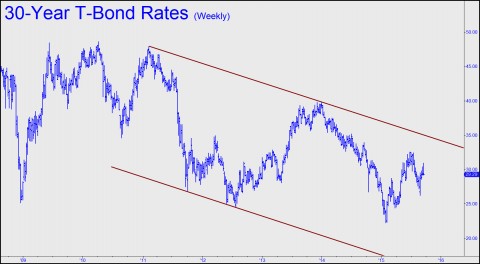[With the Fed’s decision not to raise rates, investors are more likely to return their focus to the deflationary forces that have been pushing government bond prices higher, and yields lower, for decades. Look for this trend to continue and possibly pick up steam in the months ahead, says our good friend Doug Behnfield in the guest commentary below. The Colorado-based financial adviser has contributed to Rick’s Picks many times in the past. He believes, as we do, that odds of a rate hike are remote and that it might have to wait until the next recovery cycle, which could feature inflation brought on by protectionism. (What would happen if rates go negative, as now seems possible? Click here for a scary rumination on the subject at ZeroHedge.)]
On Thursday the Fed announced that they would not be raising rates in addition to once again downgrading their expectations for economic growth and inflation looking out over the next couple of years. The response in the stock market has been negative; and for bonds, particularly the closed end Municipal Bond Funds, extremely positive. That is probably not what most were expecting. It has been my contention that the Fed is unlikely to raise rates at all in this economic cycle that began in mid-2009, and my view appears to be supported by the current economic and market environment as well as the circumstances that Janet Yellen described as the reason for the Fed staying at 0% to 0.25% on overnight rates.
Rate-Hike Mantra
In Q1 (April 2015), a narrative began to emanate from Wall Street that first-quarter economic weakness was transitory and that after six years the economy was still poised to accelerate into a legitimate cyclical recovery as the year progressed. Probably by repeating the mantra enough times, it became conventional wisdom even in the face of predominantly contradictory economic developments, particularly low-inflation data. Even though the Fed became a source of extreme frustration by continuing to leave rates alone, the strength of the conviction only grew. The result was a significant back-up in interest rates. That has most likely come to an end, leaving the potential for a meaningful decline in rates and higher bond prices in coming months and quarters (see chart below).
 One big question is: Why was Wall Street so gung-ho on the Fed raising rates? My answer to that is that collectively, “sell-side” market analysts and the Wall Street media pundits desperately wanted the Fed to endorse their dogmatic view of the economic outlook, without much regard for the damage that a rate hike might do to the economy. The narrative of sustainable economic expansion rendering 0% rates inappropriate became conventional wisdom, along with the idea that since things are so rosy, a rate hike would be a good thing, whatever that means.
One big question is: Why was Wall Street so gung-ho on the Fed raising rates? My answer to that is that collectively, “sell-side” market analysts and the Wall Street media pundits desperately wanted the Fed to endorse their dogmatic view of the economic outlook, without much regard for the damage that a rate hike might do to the economy. The narrative of sustainable economic expansion rendering 0% rates inappropriate became conventional wisdom, along with the idea that since things are so rosy, a rate hike would be a good thing, whatever that means.
Protectionism on Horizon
With the recent dramatic reversal in global equity markets and ongoing disappointment in global economic trends, it seems more likely that the “lift-off” that is so widely anticipated will have to await until the next economic expansion.
As an aside, my next Quarterly Commentary will explore protectionism as a theme that should develop well beyond Donald Trump’s success in the polls and become a major inflationary force in the next cyclical recovery. But looking immediately ahead, the deflationary forces that have been driving the long-term uptrend in government bond prices, and the resulting decline in yields, should continue to be the dominant factor driving the markets — perhaps with much more intensity.

$UST target +17% to 149
$USB not so much right now